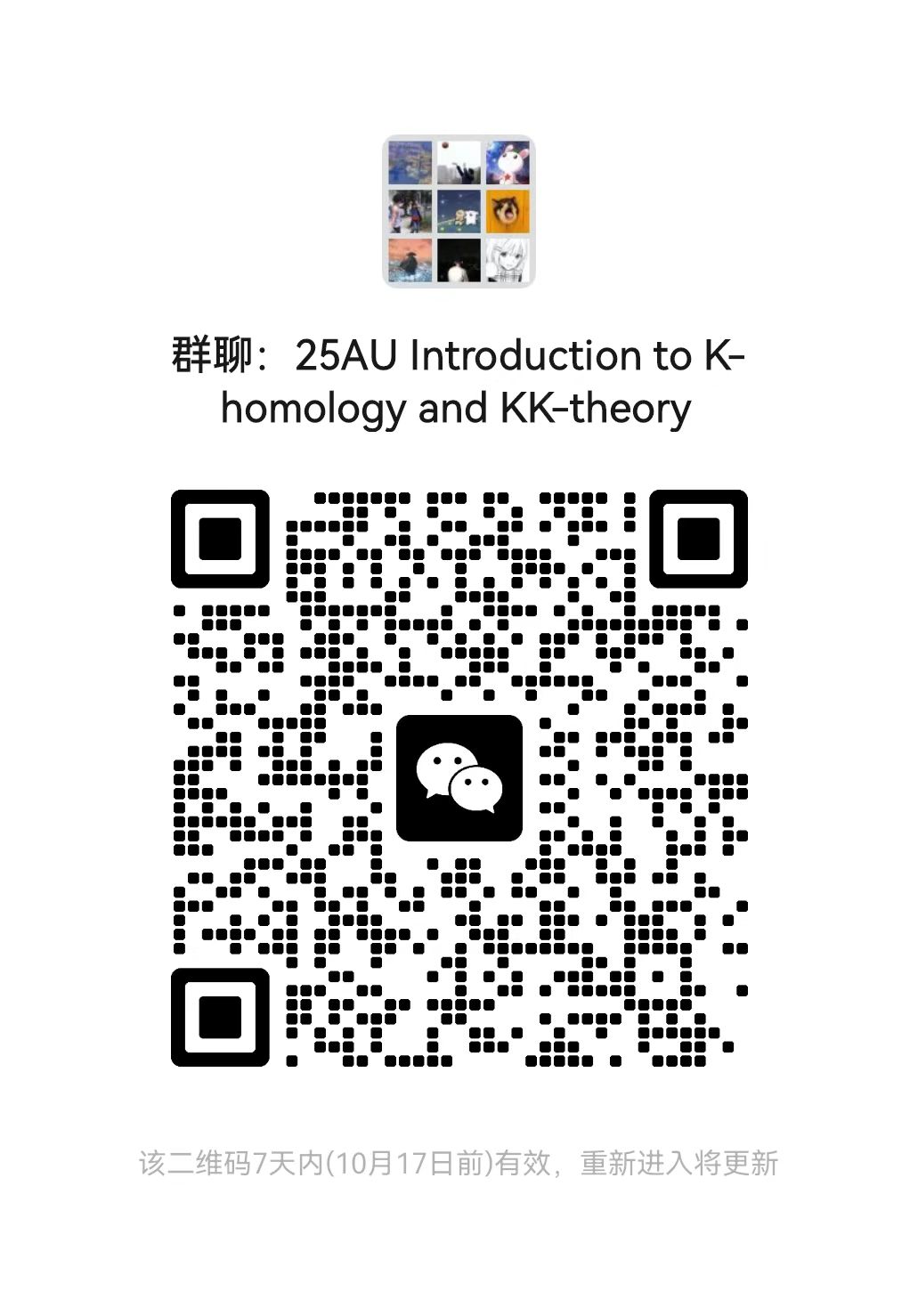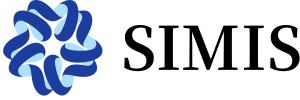K-homology and KK-theory
K-theory, as the study of stable isomorphism classes of vector bundles, originated in the work of Grothendieck in 1950's as part of his programme of revolutionising algebraic geometry. In later work, it was turned into a "universal" cohomology theory, indispensable for the study of both commutative and non-commutative algebras, starting with the work of Bott, Atiyah, and many others. The dual homology theory, the K-homology, came relatively soon afterwards, its geometric picture essentially due to Atiyah. In this picture, elliptic differential operators on vector bundles and their indices played a prominent role.
Parallel to this, K-homology appeared in the work of Brown, Douglas, and Fillmore who studied a completely different question. The problem was as follows. Given a bounded operator A on a Hilbert space which is almost normal, i.e. A*A - AA* is a compact operator, under what conditions does there exist a normal operator B such that A-B is a compact operator. The most natural language for this kind of problem is that of equivalence classes of extensions. As it turned out, the involved extension theory was "just" another version of K-homology (for C*-algebras).
The C*-algebras entered naturally in the picture via Grothendieck's basic philosophy, which says that a study of a space M with some structure (smooth, analytic, algebraic, measurable) is equivalent to the study of the corresponding algebra of functions A = C#(M), where # refers to the structure in question. It is quite natural to use the language of non-commutative geometry, where the algebra A does not have to be commutative and hence the notion of "points" does not survive. The C*-structure is, to a degree, a generalisation of the algebra complex valued continuous functions on a compact space or, at the other extreme, of the algebra of compact operators on a separable Hilbert space appearing in quantum mechanics.
Finally, in the hands of Kasparov, the K-theory and K-homology became a bi-variant functor, the KK-theory. While the existence of a bivariant theory is, from a purely topological/homological algebra point of view, quite natural, the Kasparov approach is based on the construction of KK-cycles, which somehow mirror elliptic operators in the non-commutative algebra context and satisfies remarkable properties which make it a very versatile tool in many situations.
Kasparov's original motivation was the Novikov conjecture, which since then has become the main subject of coarse geometry. However, many computations in K-theory and classification theory of C*-algebras and group actions still rest on the full power of KK-theory.
Parallel to this, K-homology appeared in the work of Brown, Douglas, and Fillmore who studied a completely different question. The problem was as follows. Given a bounded operator A on a Hilbert space which is almost normal, i.e. A*A - AA* is a compact operator, under what conditions does there exist a normal operator B such that A-B is a compact operator. The most natural language for this kind of problem is that of equivalence classes of extensions. As it turned out, the involved extension theory was "just" another version of K-homology (for C*-algebras).
The C*-algebras entered naturally in the picture via Grothendieck's basic philosophy, which says that a study of a space M with some structure (smooth, analytic, algebraic, measurable) is equivalent to the study of the corresponding algebra of functions A = C#(M), where # refers to the structure in question. It is quite natural to use the language of non-commutative geometry, where the algebra A does not have to be commutative and hence the notion of "points" does not survive. The C*-structure is, to a degree, a generalisation of the algebra complex valued continuous functions on a compact space or, at the other extreme, of the algebra of compact operators on a separable Hilbert space appearing in quantum mechanics.
Finally, in the hands of Kasparov, the K-theory and K-homology became a bi-variant functor, the KK-theory. While the existence of a bivariant theory is, from a purely topological/homological algebra point of view, quite natural, the Kasparov approach is based on the construction of KK-cycles, which somehow mirror elliptic operators in the non-commutative algebra context and satisfies remarkable properties which make it a very versatile tool in many situations.
Kasparov's original motivation was the Novikov conjecture, which since then has become the main subject of coarse geometry. However, many computations in K-theory and classification theory of C*-algebras and group actions still rest on the full power of KK-theory.

讲师
日期
2025年10月23日 至 12月04日
位置
| Weekday | Time | Venue | Online | ID | Password |
|---|---|---|---|---|---|
| 周四 | 17:05 - 18:40 | Tsinghua-6A101 | ZOOM 07 | 559 700 6085 | BIMSA |
| 周四 | 19:20 - 20:55 | Tsinghua-6A101 | ZOOM 07 | 559 700 6085 | BIMSA |
课程大纲
- Some basic facts about C*-algebras and their K-theory
- K-homology
- Deefinitions, K- homology and extensions
- Technical theorems (Stinespring, Voiculescu Weyl-von Neumann, Kasparov technical theorem), the technology of essential representations
- Paschke duality, excision, and Bott periodicity
- BDF theory
- KK-theory
- Basic definitions and properties of KK-functors
- Kasparov product (Cuntz and Connes-Skandalis pictures)
- Group actions and assembly map, γ-element
- Homological algebra in KK
- Universal coeffcient theorem
- Strong Baum-Connes conjecture.
视频公开
公开
笔记公开
公开
语言
英文
讲师介绍
I am interested in non-commutative geometry in the widest sense. Some topics that I have been involved in:
• The C*-algebraic picture of the standard model, approach to quantum gravity and structure of Quantum Groups;
• Non-commutative probability, von Neumann algebras and applications to the invariants of three manifolds, and TQFT;
• Equivariant K- and KK-theory including homological approach and applications to Baum-Connes conjecture and classification theory of nuclear C*-algebras;
• Index theory in both analytic and formal algebraic context theory with applications to analysis, to complex and differential geometry;
• Homological algebra, deformation theory, algebraic K-theory and cyclic homology;
• Quantum Field Theory, Solitons, Loop Quantum Gravity, eksperimental low temperature physics.
My publication list: https://publicationslist.org/Ryszard_Nest
For PhD-students, see https://genealogy.math.ndsu.nodak.edu/id.php?id=43937
A bit about my past:
1976 master degree - in between a high school teacher - 1987 phD-degree, both Copenhagen University. Since then tenured position at Copenhagen University
2005 - 2020 professor, Mathematics Institute, Copenhagen University, since 2020 professor emeritus position
2004 - Main organiser (with Max Karoubi) of the semester on Non-commutative geometry and K-theory, centre Emile Borel, Paris, France
2005-2008 - Director of the FNU Center of Non-commutative Geometry, at Mathematics Department, Copenhagen University
2007 - Member of the board of Center for noncommutative geometry and topology, Fredericton, Canada
2009 - Invited speaker at the International Congress of Mathematical Physics, Prague, 2009
2010 - Member of the advisory board of the Programme in Non-Commutative Geometry, RIMS, Kyoto
Since 2020 - Editor duties: The Journal of Non-Commutative Geometry, Georgian Journal of Mathematics
Since 2022 - Ulam professor, Boulder CO
Since 2023 - Gauss professor, Göttingen DE
2018-2024 - Member of the evaluation panel for the ERC advanced grants applications
Since 2024 - At present BIMSA visiting position
• The C*-algebraic picture of the standard model, approach to quantum gravity and structure of Quantum Groups;
• Non-commutative probability, von Neumann algebras and applications to the invariants of three manifolds, and TQFT;
• Equivariant K- and KK-theory including homological approach and applications to Baum-Connes conjecture and classification theory of nuclear C*-algebras;
• Index theory in both analytic and formal algebraic context theory with applications to analysis, to complex and differential geometry;
• Homological algebra, deformation theory, algebraic K-theory and cyclic homology;
• Quantum Field Theory, Solitons, Loop Quantum Gravity, eksperimental low temperature physics.
My publication list: https://publicationslist.org/Ryszard_Nest
For PhD-students, see https://genealogy.math.ndsu.nodak.edu/id.php?id=43937
A bit about my past:
1976 master degree - in between a high school teacher - 1987 phD-degree, both Copenhagen University. Since then tenured position at Copenhagen University
2005 - 2020 professor, Mathematics Institute, Copenhagen University, since 2020 professor emeritus position
2004 - Main organiser (with Max Karoubi) of the semester on Non-commutative geometry and K-theory, centre Emile Borel, Paris, France
2005-2008 - Director of the FNU Center of Non-commutative Geometry, at Mathematics Department, Copenhagen University
2007 - Member of the board of Center for noncommutative geometry and topology, Fredericton, Canada
2009 - Invited speaker at the International Congress of Mathematical Physics, Prague, 2009
2010 - Member of the advisory board of the Programme in Non-Commutative Geometry, RIMS, Kyoto
Since 2020 - Editor duties: The Journal of Non-Commutative Geometry, Georgian Journal of Mathematics
Since 2022 - Ulam professor, Boulder CO
Since 2023 - Gauss professor, Göttingen DE
2018-2024 - Member of the evaluation panel for the ERC advanced grants applications
Since 2024 - At present BIMSA visiting position




